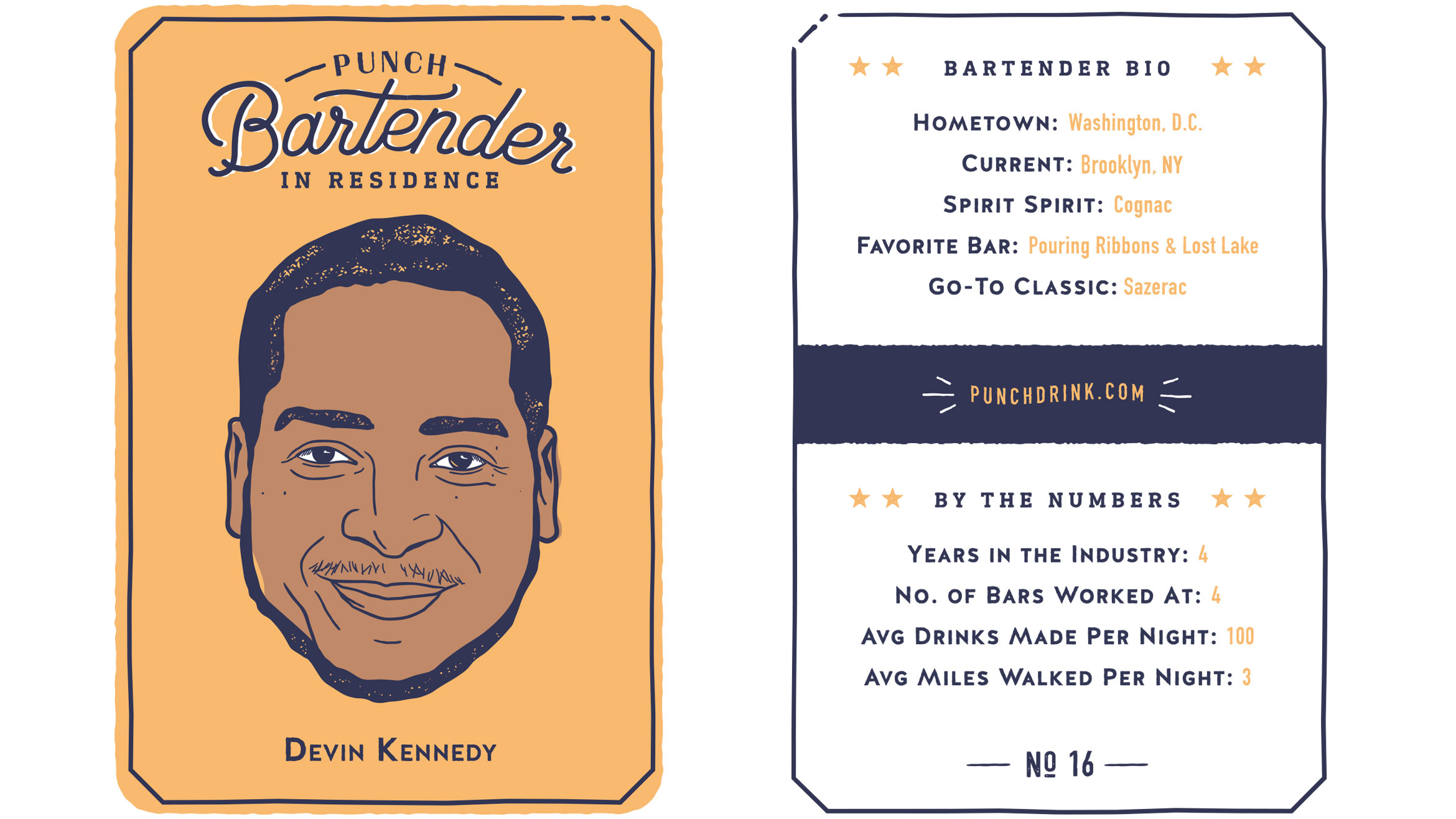“I’m very, very simple,” insists Devin Kennedy. It’s not a statement you’d expect from a bartender whose drinks exist outside the bounds of traditional formulas—Piña Coladas built on Madeira, force-carbonated Pimm’s Cups. But for Kennedy, simplicity does not mean simplistic.
“I tend to work within a couple of core syrups, your basic citrus and the backbar,” he says. It’s an approach born more from necessity than anything else. While bartending at Brooklyn’s Grand Army (“It’s a super tiny bar with not a lot of prep space”), Kennedy turned his attention away from proprietary—and more complicated—tinctures and syrups and toward finding nuance in existing ingredients, and discovering how best to draw those flavors to the fore.
It’s a practice that has stuck with him throughout his career, becoming a driving philosophy along the way—first at Grand Army, where he worked under co-owner Damon Boelte in 2016; then at Danny Meyer’s Union Square Cafe, whose new Park Avenue location he helped open also in 2016; and at Cote, the Korean steakhouse from restaurateur Simon Kim, which he helped open in 2018. “Most of my drinks that I put on [those] menus have all been pretty backbar-focused,” says Kennedy, referencing his interest in working with products that can be found at just about any bar. “[I focus on] just mastering how to use your simple syrup, your demerara, your cane, how to really use lemon and lime, and how to pick the right spirit for the right cocktail,” says Kennedy. “All whiskies are not the same; all gins are not the same,” he notes, adding that he’ll often test upward of six bottlings for each cocktail he creates.
This approach to simplicity has only become more refined since Kennedy joined the team at Pouring Ribbons a year and a half ago. There, owner Joaquín Simó reinforces a tenet that dictates so many canonical classics, from the Manhattan to the Martini: If an ingredient isn’t contributing to a drink, it doesn’t belong in the drink. While you might expect this insistence on simplicity to yield a predictable roster of cocktails, Kennedy manages to break away from boilerplate builds, often by leaning on base spirits as supporting players and letting modifiers steal the show. The resulting drinks are ones that fall neither entirely within, nor wholly outside of, recognizable constructions.
Take the Billy Ray Valentine for example. Though it reads like a textbook Piña Colada, the drink relies on only half an ounce of rum. In its place, a 3 Year Madeira stands in to yield a more sessionable interpretation of the tropical classic. His Spice Adams likewise inverts expectations by leaning on a full ounce and a half of falernum, a spiced modifier typically used only in supporting roles, as a key flavoring agent. By using well-known ingredients in unexpected ratios, Kennedy creates cocktails that are familiar without feeling formulaic.
Here, get to know Devin Kennedy in four cocktails that best represent his style.
Spice Adams
“This drink is pretty weird,” Kennedy admits, noting that it falls somewhere between a Corn ’n’ Oil and a Mojito, though it reads like something else entirely. The most abundant ingredient is the falernum, which does double duty as a sweetener and a flavoring agent, bringing a pronounced clove and allspice note to the mixture. An ounce of agricole rum lends a grassy, acidic base note, which is offset by the more confectionary aroma of the pineapple rum that is floated on top of the finished drink. In Kennedy’s candid take, “It’s kind of like a mindfuck.”
Rule of Three
In this equal-parts concoction, Kennedy crafts a Martini by way of Spain. Spanish gin, Spanish vermouth and dry sherry are stirred together with a grapefruit peel to incorporate citrus oil throughout the cocktail rather than simply spritzing it over the surface of the drink. Perhaps more than any other cocktail, Kennedy’s Rule of Three follows his driving principle: “Let’s keep it simple.”
B*A*P*S
“I wanted a light, bright drink that I could imagine drinking in California,” says Kennedy of the inspiration behind his B*A*P*S, named for the 1997 comedy starring Halle Berry, in which the protagonists move from Decatur, Georgia, to Beverley Hills to care for a millionaire, enjoying a lavish lifestyle by proximity. “This is something I would imagine them drinking,” says Kennedy. Naturally, the recipe calls on California brandy, used here as a modifier, keeping the drink at a lower proof for easy drinking. Pimm’s stands in as the base spirit, while a measure of lime stock—Pouring Ribbons keeps this eco-alternative to fresh lime juice on hand—and a dash of cucumber bitters nod to the classic Pimm’s Cup accompaniments. Rather than top the whole thing with sparkling lemonade as one might expect, Kennedy force-carbonates the cocktail to stretch out the final flavors.
Billy Ray Valentine
In this spin on the Piña Colada, Kennedy uses just a half-ounce of Trinidadian rum, letting Madeira contribute most of the body to the cocktail. To the expected coconut and pineapple juice, he also adds a half-ounce of amontillado sherry, for a slight nutty note, and a teaspoon each of cinnamon syrup and banana liqueur as “the salt and pepper.” It is, in Kennedy’s words, “the perfect Piña Colada.”









